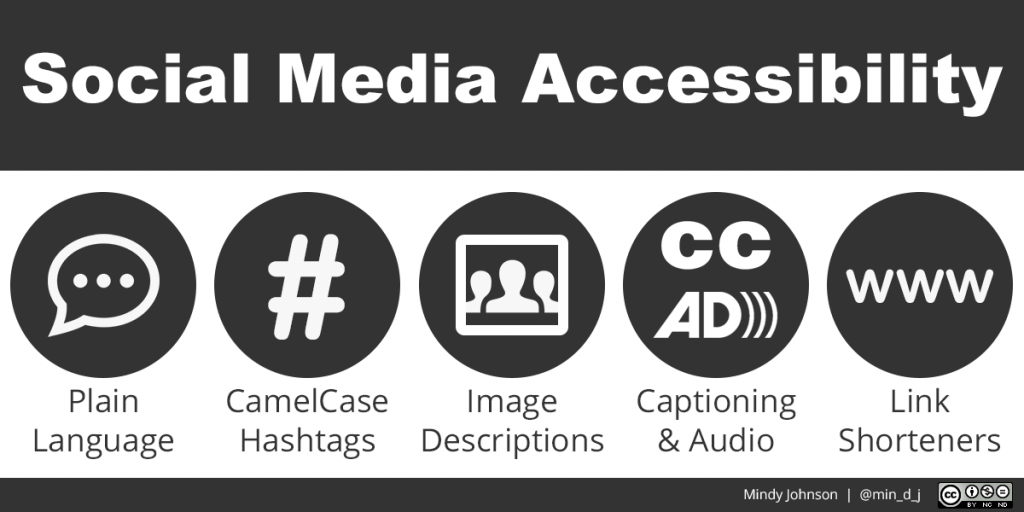Social Media Accessibility Checklist
There are some basic best practices you can implement to keep your content accessible to all users that may see your social media content.
Accessible social media best practices in use makes a big impact on the experience that users with vision and/or hearing disabilities have on social media.
Use the below checklist to double-check your content before posting it.
Hashtags
- Use hashtags in moderation.
- Put multi-word hashtags in Camel Case.
- Place hashtags at the end of posts and tweets when possible.
- lace hashtag clouds in the first comment of Instagram posts instead of the caption.
Images
- Add alt text to all images, including GIFs.
- Add alt text for all copy on images that include flattened text.
- If an image has excessive flattened copy on it (i.e. an official statement or organizational update), link out from the post or tweet to a webpage where the full statement is available as readable text and add alt text to the image.
Videos
- Add closed captioning to all videos that contain dialogue and/or audio.
- Provide a written or audio description of a video if it does not contain audio.
- Add open captioning to videos where closed captioning is not possible (i.e. Story features, Instagram Reels, TikTok, etc…)
- Avoid using flashing lights or strobe effects in videos.
- Make live captioning and/or an on-camera interpreter available for live videos.
Emojis
- Use emojis in moderation.
- Do not use emojis as bullet points.
- Avoid putting emojis in the middle of written content.
- Stick to default yellow emojis unless a custom skin tone is necessary for context.
- Double-check the descriptions of emojis on emojipedia.org before using them.
Characters & Symbols
- Do not use special Unicode characters from external websites to make type appear in different styles or fonts.
- Do not use ASCII Art in posts or tweets.
Glossary
Alternative Text
Alternative text—more commonly known as alt text—is the meta description of an image that a screen reader uses to accurately describe it aloud to blind and visually impaired users.
The platforms Facebook, Twitter, Instagram, and LinkedIn allow users to write custom alt text for in-feed images. Twitter also allows users to write alt text for Fleets, their Story feature.
ASCII Art
ASCII Art is a design technique that uses characters to create illustrative pictures.
However, screen readers cannot decipher ASCII Art and attempt to read the individual characters that make the illustration up instead. Therefore, ASCII Art is not accessible.
Audio Description
Verbalized description of a video that allows blind and visually impaired users to understand its content.
On streaming services like Netflix and Disney+, an audio description is available as a track separate from the closed captions track. The platforms YouTube and Vimeo do not allow for separate audio description tracks, unfortunately.
Camel Case
Camel Case—also known as Pascal Case and Title Case—is the method of capitalizing each word in a multi-word hashtag so that screen readers say it correctly.
Examples: #SocialMediaRocks, #UseCamelCase, #GoAlexa
Closed Captions
Closed captioning (CC) and subtitling are both processes of displaying text on a video to provide interpretive info about the dialogue or other audio in the video.
Subtitles are intended for viewers who can’t understand the language being spoken in the video. Closed captions can be toggled on and off.
Emojis
Colorful icons popular on social media.
Every individual icon—including ones with custom skin tones—has its own unique description assigned to it that is read aloud when a screen reader comes across an emoji in content. The appearances and descriptions of emojis can vary based on the device or platform they are being viewed on.
Use the site emojipedia.org to double-check emoji descriptions.
Flattened Text
Text on digital assets such as images and/or PDF files that has been turned into an object and is no longer recognized by a screen reader as readable characters.
Flattened text is easily identified by dragging your mouse over the copy in question and seeing if you can highlight the individual words.
Open Captions
Captions or subtitles that are burned into a video during post-production and always visible.
They cannot be turned off by viewers.
Screen Reader
Assistive software program that allows blind and visually impaired users to consume the text that is displayed on a screen with a speech synthesizer or braille display.
Most smart phones have screen readers built into them. On iPhone, the program is called VoiceOver. On Android devices, it’s called TalkBack.
Special Unicode
Characters copied and pasted from external websites like IGFonts.io and CoolFont.org that are visually different from the social media platform’s native type.
This trend became popular on Instagram and has spread to the other platforms. However, not all screen readers can decipher these special Unicode characters, making them inaccessible.
Written By: Alexa Heinrich ·
This resource was created by Alexa Heinrich and is shared with permission.
If you have questions or want to learn more about how you can improve your digital accessibility skills, feel free to reach out to me at hello@therealalexa.com.

